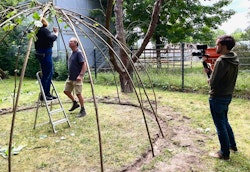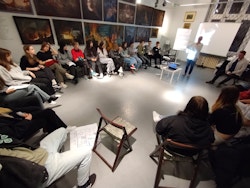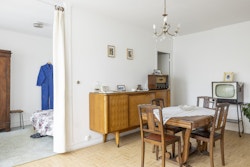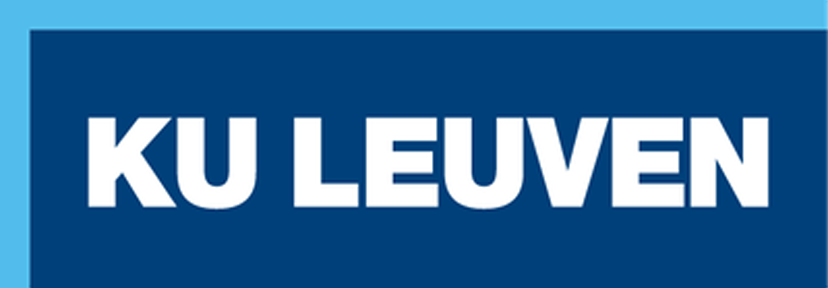Citizen Science Toolkit
Co-developed by
Discover our experts' citizen science projects
The Interaction Lab
Antje Wilton, Freie Universität Berlin
The Interaction Lab project, led by Antje Wilton, professor of English sociolinguistics at FU Berlin, is centered around the construction of a Mesolithic hut on the university campus. The design of the hut was based on a local discovery from Brandenburg and executed by experts in ancient technology and experimental archaeology. The construction took place during two events: the Long Night of Sciences in Berlin on June 17, 2023, and the European Archaeology Days from June 16 to 18, 2023, and actively involved citizens. The entire building process was documented through audiovisual recordings captured from different perspectives to get interactional data for linguistic and interaction analytic investigation.
The establishment of the hut marked the inception of a new Interaction Lab which plans to incorporate various prehistoric structures to investigate diverse aspects of social interaction within heritage environments.
The Interaction Lab project remains ongoing. The updates on its progress are available through its Twitter account (@interactionlab_) and the project's dedicated blog. The project team encourages individuals interested in collaboration to get in touch.

GRETA (GReen Energy Transition Action)
Francesca Sabatini, Alma Mater Studiorum - Università di Bologna
Francesca Sabatini, a postdoctoral research fellow in the TRACE research team at Università di Bologna's Department of Architecture, is actively participating in the GRETA project. GRETA aims to observe the intricate factors that facilitate energy citizenship and the transition towards sustainable lifestyles. The project, funded by the Horizon 2020 (GA 101022317), is a collaborative effort involving eight partners from six EU countries. The Bologna academic team was composed of a core of architects, engineers and sociologists reconciling technological and social aspects.
The project posits that technology alone is not enough to achieve climate neutrality. It focuses on energy justice and aims to establish renewable energy communities in areas affected by energy poverty. Developing energy citizenship and empowering communities plays a crucial role in enabling them to generate sustainable energy and shape their energy future through meaningful political engagement.
The project encompasses various case studies, including the Pilastro-Roveri district in Bologna. To engage citizens, researchers employed effective techniques such as co-design labs, gamification experiences, neighbourhood walks and others, also involving local stakeholders and mediators, to foster a sense of belonging and augment the community's understanding of the district and of energy matters through direct citizen involvement.
CUTE – Cultural Heritage at The Edge
Ruxandra-Iulia Stoica, University of Edinburgh
The CUTE project (2021-22) addressed the complexities and contradictions inherent in dealing with cultural heritage in seven case studies of peripheral urban areas across Europe. The project was led by Université Paris 1 Panthéon-Sorbonne and involved partners from the University of Edinburgh, University Complutense Madrid, Alma Mater Studiorum Università di Bologna, Uniwersytet Jagielloński w Krakowie, Helsingin yliopisto/ Helsingfors universitet and KU Leuven.
Edinburgh's case study was Granton in the northern periphery, where the city meets the sea. The project team brought together academics and postgraduate students from Edinburgh College of Art and members of the local community through the local history, arts and community group at Granton Hub. The project was designed to use direct input from the local inhabitants with the stated aim of trying to uncover what the heritage construct is for people from the local community and compare that with the institutionalised construct of official heritage listings and designations.
The project received funding from the Una Europa Seed Funding initiative and, for the Edinburgh case study, an Edinburgh College of Art Knowledge Exchange and Impact Grant.

DeepFIN and DigiNUMA
Eljas Oksanen, Helsingin yliopisto/ Helsingfors universitet
Led by Eljas Oksanen, a researcher at the Department of Cultures at the University of Helsinki, DeepFIN is a EU-funded project that focuses on the analysis of archaeological public findings collected by the Finnish Heritage Agency. These findings, despite their potential, have not been yet explored. By utilizing geographic information systems and other digital humanities methodologies, DeepFIN aims to delve into the deep history of archaeological landscapes, historical settlements, and the evolution of material culture, spanning from the Iron Age to the Middle Ages. As the project relies on crowdsource-generated data, it makes citizen participation a crucial aspect of its existence.
DeepFIN is supported by another project called DigiNUMA, which seeks to establish ontological infrastructure and a proof-of-concept data service model for harmonizing and opening national and international databases containing archaeological finds data from Finland, the UK, and the EU.
Oddzial Od/Nowa (Re/New Department)
Kinga Anna Gajda, Uniwersytet Jagielloński w Krakowie
Kinga Anna Gajda, a professor of cultural studies at Jagiellonian University, has been approached by the Metallurgy Museum in Chorzów, which is embarking on a new department establishment and a renewal of its exhibition. The museum faces the challenge of deciding between organizing a permanent exhibition or focusing on temporary exhibitions. Additionally, it aims to effectively showcase the history of Chorzów, a city located in Silesia.
Within this project, Kinga Gajda represents the scholarly and academic perspective. She closely collaborates with a project partner, Piotr Michałowski, who represents private companies and businesses, as well as with museum experts, and the citizens of Chorzów. To actively involve the citizens, a workshop was organized, gathering various members of the Chorzów community including students, teachers, seniors, local government officials, and business representatives. Furthermore, interviews and an online questionnaire were conducted to capture the diverse stories and viewpoints of the citizens.
The involvement of the citizens holds utmost importance in this project, as the museum's core objective is to meet the needs of the community and ensure their voices are not only heard but genuinely incorporated. The museum stands as a collective endeavour, dedicated to the citizens and shaped by their experiences.

The Story Mapper
Hanne Vrebos, KU Leuven
In collaboration with fellow researchers, Hanne Vrebos, a doctoral researcher at KU Leuven, launched the project "The Story Mapper". This project aims to explore a novel method of citizen participation in neighbourhoods undergoing transition. It has been implemented as part of the municipal initiative in a small village called Veltem-Beisem, which actively involves citizens in the reflections on repurposing of the local church into a new community building.
At the heart of the project lies the 'StoryMapper', a unique placemaking tool consisting of small drawing boards with transparent plexiglass. These boards were distributed among the residents, enabling them to envision and depict the changes they would like to witness in a specific location. The resulting drawings were then uploaded to a digital platform alongside accompanying stories. This amalgamation of visual representations and narratives formed a living map, where the gathered data was made accessible, intricately connecting each contribution to its corresponding physical location.
Through the 'StoryMapper', the researchers sought to provide an alternative means of gathering input from citizens, testing the hypothesis that certain emotional insights are best conveyed and shared through visual and emplaced representations. This innovative approach encourages active citizen engagement and enables a deeper exploration of their perspectives on the transformation of their neighbourhood.

Projects of UCM's Cultural Heritage Management research group
Alicia Castillo Mena, Universidad Complutense de Madrid
Since 2010, the Cultural Heritage Management research group at Universidad Complutense def Madrid has worked on over 20 citizen science projects. Alicia Castillo Mena, the group's director, tells us in her interviews about the key challenges she has encountered and highlights some of her most interesting projects from the field of social innovation. These include organizing International Congresses of Good Practices in World Heritage and conducting participatory research initiatives with communities and stakeholders in Europe and Latin America. While some of these projects limit the production of collective knowledge to expert groups and communities, others extend it to vulnerable and peripheral neighbourhoods in World Heritage cities or high-risk contexts, such as the project implemented after the volcanic eruption on the Island of La Palma. The interview emphasizes the belief that participatory research in cultural heritage management should prioritize commitment, shared responsibility, learning, enjoyment, and respect among all participants involved.

La Vie HLM (Life in Public Housing)
Fabrice Langrognet, Université Paris 1 Panthéon-Sorbonne
Dr. Fabrice Langrognet is a researcher in migration history at the Centre d’histoire sociale des mondes contemporains (Paris 1/CNRS) and at the University of Oxford, actively involved in the France-based Association pour un Musée du logement populaire (AMULOP). Since 2014, this organization is working towards a museum, located in the Paris suburbs, centered on the history of French working-class neighborhoods. Through the prism of housing, this original landmark will display life stories of past inhabitants. This project brings together researchers from multiple disciplines, including history, sociology, anthropology, and art history, alongside educators, archivists and museum designers.
This approach has been tested by AMULOP in a successful exhibition, entitled ‘La Vie HLM’ (lit. ‘life in public housing’) which ran in Aubervilliers, France, from October 2021 to June 2022. Visitors of the exhibition were able to immerse themselves in the apartments, and the lives, of four families who resided in one particular public-housing unit, from the 1950s to the 2000s. Through 45-min guided tours, the exhibition provided a unique opportunity to engage with the history and foster a deeper understanding of the transformation of the Paris ‘banlieues’ in the second half of the 20th century. The participation of local stakeholders, including residents, community organizations, and local institutions, was key throughout the research and curation process.








